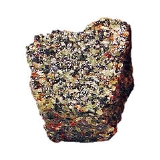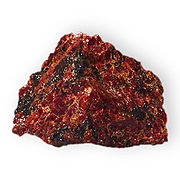
Willemite
Encyclopedia
Willemite is a zinc
silicate mineral (Zn
2Si
O
4) and a minor ore of zinc
. It is highly fluorescent (green) under shortwave ultraviolet
light.
It occurs in all different colors in daylight, in fibrous masses, solid brown masses ("troostite"), and apple green gemmy masses.
It was discovered in 1830 and named after William I of the Netherlands.
ore bodies, and is usually associated with limestone
. It occurs in many places, but is best known from Arizona and the zinc, iron, manganese deposits at Franklin
and Sterling Hill Mines in New Jersey
. It often occurs with red zincite
(zinc oxide) and franklinite
(Fe
,Mn
,Zn)(Fe,Mn)2O4 (an iron rich zinc mineral occurring in sharp black isometric octahedral crystals and masses). Franklinite and zincite are not fluorescent.
. In the 1940s it was largely replaced by the second generation halophosphors based on the fluorapatite
structure. These, in turn have been replaced by the third generation TriPhosphors.

Zinc
Zinc , or spelter , is a metallic chemical element; it has the symbol Zn and atomic number 30. It is the first element in group 12 of the periodic table. Zinc is, in some respects, chemically similar to magnesium, because its ion is of similar size and its only common oxidation state is +2...
silicate mineral (Zn
Zinc
Zinc , or spelter , is a metallic chemical element; it has the symbol Zn and atomic number 30. It is the first element in group 12 of the periodic table. Zinc is, in some respects, chemically similar to magnesium, because its ion is of similar size and its only common oxidation state is +2...
2Si
Silicon
Silicon is a chemical element with the symbol Si and atomic number 14. A tetravalent metalloid, it is less reactive than its chemical analog carbon, the nonmetal directly above it in the periodic table, but more reactive than germanium, the metalloid directly below it in the table...
O
Oxygen
Oxygen is the element with atomic number 8 and represented by the symbol O. Its name derives from the Greek roots ὀξύς and -γενής , because at the time of naming, it was mistakenly thought that all acids required oxygen in their composition...
4) and a minor ore of zinc
Zinc
Zinc , or spelter , is a metallic chemical element; it has the symbol Zn and atomic number 30. It is the first element in group 12 of the periodic table. Zinc is, in some respects, chemically similar to magnesium, because its ion is of similar size and its only common oxidation state is +2...
. It is highly fluorescent (green) under shortwave ultraviolet
Ultraviolet
Ultraviolet light is electromagnetic radiation with a wavelength shorter than that of visible light, but longer than X-rays, in the range 10 nm to 400 nm, and energies from 3 eV to 124 eV...
light.
It occurs in all different colors in daylight, in fibrous masses, solid brown masses ("troostite"), and apple green gemmy masses.
It was discovered in 1830 and named after William I of the Netherlands.
Formation and associated minerals
Willemite is usually formed as an alteration of previously existing sphaleriteSphalerite
Sphalerite is a mineral that is the chief ore of zinc. It consists largely of zinc sulfide in crystalline form but almost always contains variable iron. When iron content is high it is an opaque black variety, marmatite. It is usually found in association with galena, pyrite, and other sulfides...
ore bodies, and is usually associated with limestone
Limestone
Limestone is a sedimentary rock composed largely of the minerals calcite and aragonite, which are different crystal forms of calcium carbonate . Many limestones are composed from skeletal fragments of marine organisms such as coral or foraminifera....
. It occurs in many places, but is best known from Arizona and the zinc, iron, manganese deposits at Franklin
Franklin Furnace
Franklin Furnace, also known as the Franklin Mine, is a famous mineral location for rare zinc, iron, manganese minerals in old mines in Franklin, New Jersey, USA. This locale produced more species of minerals and more different fluorescent minerals than any other location...
and Sterling Hill Mines in New Jersey
New Jersey
New Jersey is a state in the Northeastern and Middle Atlantic regions of the United States. , its population was 8,791,894. It is bordered on the north and east by the state of New York, on the southeast and south by the Atlantic Ocean, on the west by Pennsylvania and on the southwest by Delaware...
. It often occurs with red zincite
Zincite
Zincite is the mineral form of zinc oxide . Its crystal form is rare in nature; a notable exception to this is at the Franklin and Sterling Hill Mines in New Jersey, an area also famed for its many fluorescent minerals. It has a hexagonal crystal structure and a color that depends on the presence...
(zinc oxide) and franklinite
Franklinite
Franklinite is a mineral with formula ZnFe2O4. It is associated with the Franklin Mine and Sterling Hill Mines in New Jersey.-See also:* Spinel* Classification of minerals* List of minerals-References:*...
(Fe
Iron
Iron is a chemical element with the symbol Fe and atomic number 26. It is a metal in the first transition series. It is the most common element forming the planet Earth as a whole, forming much of Earth's outer and inner core. It is the fourth most common element in the Earth's crust...
,Mn
Manganese
Manganese is a chemical element, designated by the symbol Mn. It has the atomic number 25. It is found as a free element in nature , and in many minerals...
,Zn)(Fe,Mn)2O4 (an iron rich zinc mineral occurring in sharp black isometric octahedral crystals and masses). Franklinite and zincite are not fluorescent.
Uses
Artificial willemite was used as the basis of first generation fluorescent tube phosphors. Doped with manganese-II, it fluoresces with a broad white emission band. Some versions had some of the zinc replaced with berylliumBeryllium
Beryllium is the chemical element with the symbol Be and atomic number 4. It is a divalent element which occurs naturally only in combination with other elements in minerals. Notable gemstones which contain beryllium include beryl and chrysoberyl...
. In the 1940s it was largely replaced by the second generation halophosphors based on the fluorapatite
Fluorapatite
Fluorapatite, often with the alternate spelling of fluoroapatite, is a mineral with the formula Ca53F . Fluorapatite is a hard crystalline solid. Although samples can have various color , the pure mineral is colorless as expected for a material lacking transition metals...
structure. These, in turn have been replaced by the third generation TriPhosphors.


